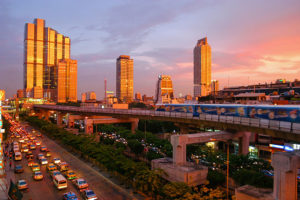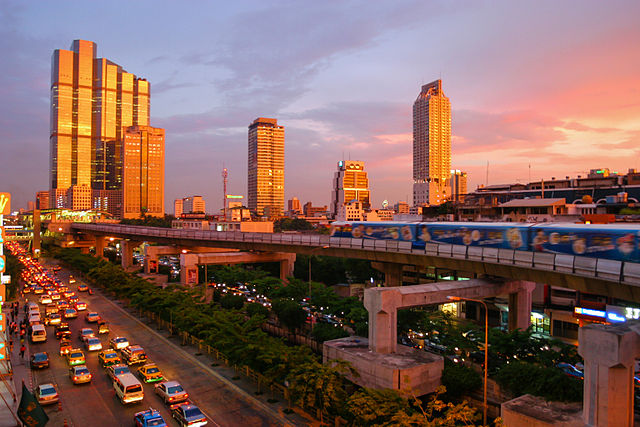 Four countries in the Association of Southeast Asian Nations (ASEAN) are expected to enter Asia’s trillionaire club in the next five to 15 years, helping to fuel the continuing rapid expansion of the Asia-Pacific region, forecasts global business analyst and consultancy IHS, Inc.
Four countries in the Association of Southeast Asian Nations (ASEAN) are expected to enter Asia’s trillionaire club in the next five to 15 years, helping to fuel the continuing rapid expansion of the Asia-Pacific region, forecasts global business analyst and consultancy IHS, Inc.
IHS predicts that over the next decade, Asia-Pacific will be the fastest growing region of the global economy and the region that offers the biggest potential gains for foreign direct investment (FDI).
The region is seen to grow at an average annual rate of 4.5% per year in the next 10 years, boosted by rapid growth in consumer spending in China, India, and Southeast Asia, according to IHS in a new study on Asia’s top 10 FDI hotspots.
Rajiv Biswas, Asia-Pacific chief economist for IHS, said a key source of strength for Asia-Pacific is “the rapidly growing size of the economic region, which now accounts for around one-third of world GDP, generating strong intra-regional trade and investment flows.”
ASEAN’s Emerging Four
Southeast Asia is predicted to be one of the world’s fastest growing regions, with four ASEAN nations—Indonesia, Malaysia, the Philippines, and Thailand—expected to join the ranks of Asia’s group of nations that have a GDP exceeding US$1 trillion by 2030.
“This will help to increase the geopolitical and economic importance of ASEAN as a political and economic grouping in international diplomacy and the global dialogue on trade, investment and international standards-setting,” Biswas said.
Indonesia, the largest economy in Southeast Asia and one of the world’s largest emerging markets, is forecast to post GDP growth of 5% per year over 2016-2020, supported by strong growth in consumer demand and infrastructure investment. By 2020, Indonesia will have already become a nation with GDP size exceeding $1 trillion, and by 2030, Indonesian GDP is projected to exceed $3.7 trillion.
“This will significantly increase Indonesia’s global geopolitical influence as a leading emerging market, shaping international policymaking in global forums such as the G-20 and United Nations,” Biswas said.
“FDI inflows into Indonesia have grown strongly over the last three years, with recent reforms announced by President Jokowi’s administration to liberalize foreign investment into service sectors such as logistics, health care and tourism,” Biswas said. “This is likely to boost FDI inflows even further.”
Indonesia has a large and fast growing population of 250 million, fast growing household spending by middlepclass households, and rapid growth projected in a wide range of industries.
“The Indonesian domestic consumer market is very attractive for multinationals,” Biswas said. “Banking, insurance, health care, construction, retailing, commercial aviation and manufacturing are all industries aiding the Indonesian success story.”
For Malaysia, the economy is forecast to achieve a per capita GDP of $20,000 by 2025, with total GDP exceeding $1 trillion by 2030. The structure of the Malaysian economy will continue to shift towards higher value-added manufacturing and services.
Strategic growth industries in the services sector will include financial services, healthcare, education, commercial aviation, tourism, and the IT-BPO industry, as Malaysia becomes an increasingly important services-exporting economy for Southeast Asia.
Likewise, the Philippines has shown rapid GDP growth averaging around 6% per year over 2011-2015, with GDP growth of 5.8% per year forecast over 2016-2018. “The total size of the Philippines’s economy is projected to grow from $300 billion in 2016 to $700 billion by 2025, and a $1 trillion economy by 2030,” Biswas said. “This will make the Philippines one of the leading emerging markets in Asia.”
Additionally, the ASEAN frontier markets of Vietnam, Myanmar, Cambodia, and Laos are forecast to continue to grow rapidly. Vietnam will grow at a pace of around 6.5% per year over the medium term, with robust growth in manufacturing exports of electronics and garments driving industrial development.
The new EU-Vietnam Free Trade Agreement and the planned Trans-Pacific Partnership deal will significantly boost Vietnam’s market access to the EU and U.S. for its manufacturing exports by reducing tariff barriers substantially.
FDI hotspots
According to the report, Asia’s top 10 FDI hotspots are China for Northeast Asia; Indonesia, Vietnam, Philippines, Myanmar, Malaysia, and Thailand for Southeast Asia; and India, Sri Lanka, and Bangladesh for the South Asian region.
The report said a key long-term growth driver in Asia-Pacific will be China’s “One Belt, One Road” initiative.
“This will be catalyzed by new infrastructure financing for Asian emerging markets into sectors such as power generation and transmission, railroads, ports and highways from the recently launched Asian Infrastructure Investment Bank, the Silk Road Fund, as well as a number of Chinese bilateral infrastructure financing commitments to a number of Asian countries,” Biswas said.
At the same time, the Indian economy is forecast to be one of the fastest growing large emerging markets over the medium term, growing at an average pace of 7.6% per year between 2016 and 2020, outpacing China for the first time in over three decades.
“The strong growth outlook for India is underpinned by improving consumer spending, accelerated infrastructure development and stronger FDI inflows. The favorable impact of low global oil prices has reduced inflationary pressures and lowered the current account deficit,” Biswas said. “The Modi government’s new initiatives to boost infrastructure development, develop smart cities and attract investment into Indian manufacturing are helping to lift FDI flows into India.”
Among the other South Asian economies, Sri Lanka and Bangladesh are expected to show rapid growth over the next decade. The Sri Lankan economy is projected to grow at an average annual pace of 5.6% per year over 2016-2020. Despite political turbulence, Bangladesh has made considerable economic progress over the past decade, with average annual GDP growth exceeding 6.5% per year since 2006. Bangladesh has emerged as an attractive location for FDI into low-cost textiles, clothing and footwear manufacturing, due to its relatively low wage costs compared to coastal China.
Photo: Diliff





